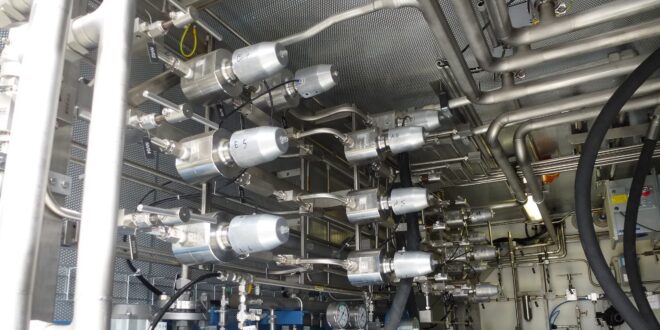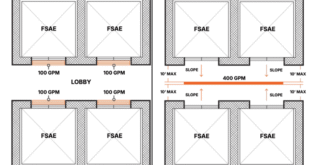As the use of hydrogen is increasing across the UK’s energy mix, safely controlling its flow is vital to realise its potential as a sustainable alternative. For vehicle refuelling, as well as use across industry, high-pressure and ultra-high-pressure hydrogen flow is vital. Understanding these distinctions and the importance of valve design in high-pressure hydrogen distribution are key to developing the required infrastructure. Tony Brennan explains
For the UK to achieve net-zero, hydrogen has an important role to play. Transport is responsible for nearly a third of the country’s total emissions, and while the EV market is growing, many vehicle operators with longer-distance requirements are looking to hydrogen as an alternative. This summer, the government announced a £500M injection to support building the UK’s first regional hydrogen transport and storage network. While there are six refuelling hubs currently in the UK, five more are scheduled to open by 2027, with plans for up to 30 new hubs by the end of the decade.
In addition to refuelling hubs for commercial vehicles, an increasing number of industry sectors across the UK are integrating their own supply of hydrogen as a power source. From bus operators through to industrial manufacturers as well as construction companies, hydrogen can help organisations achieve their net-zero ambitions, as well as providing a back-up to reinforce energy security.
With a current lack of hydrogen pipelines, and limited infrastructure to create hydrogen on-site, road transport is the flexible option. Delivering this off-grid hydrogen supply is a fleet of tube trailers, which also serves the needs of hydrogen storage. This system involves a truck-mounted frame holding a bundle of long, thick-walled pressure vessels, typically 6-12m in length, connected via a manifold. As hydrogen is compressed into the tubes, no additional infrastructure is required to access the gas; when the sealed tubes are opened, flow naturally occurs as a result of the pressure differential.
Ultra-high pressure
A requirement shared by hydrogen fuelling stations as well as tube trailer transportation and storage is the need for high pressure. In a refuelling station, hydrogen will only move from the station’s storage tanks into the vehicle’s onboard tank if it has a higher pressure. Compression at pressures between 500 to 1,000 bar allows for natural overflow into the vehicle tank at a fast flow without needing an additional compressor at the dispenser nozzle. Meanwhile, for hydrogen insertion into tube trailers, compression is raised up to between 350 bar and 500 bar, increasing hydrogen density to a higher level to optimise payload in transportation and storage.
To maintain these pressures, and ensure safe storage as well as controlled flow, valve operation is an integral link. At 350 bar and above, this is defined as ultra-high pressure, a significant classification, because to maintain safety and control, this level demands a valve with a reinforced construction. While high-pressure valves are lower rated but still designed for operation up to 350 bar, for this design of valve, the tube, which is the central bore that the hydrogen flows through, is machined and welded. However, ultra-high-pressure valves require a tube that is machined and screwed.
Hydrogen embrittlement
The reason this reinforced design is necessary is to prevent hydrogen embrittlement. This can occur when hydrogen atoms penetrate the crystal lattice inherent to the stainless-steel construction, ultimately resulting in micro-cracks that impact the valve’s integrity. At higher pressures, the greater concentration of hydrogen molecules dissipates into the stainless steel more quickly, speeding-up the embrittlement process. Whereas welding can potentially result in weak points that can be penetrated, bolting and sealing the key components of a valve can prevent this, optimising suitability for ultra-high-pressure applications.
Another area of potential weakness is the valve seat, the surface that closes against the valve tube to stop the flow and ensure a leak-tight barrier. At pressures up to 1,000 bar, this dynamic sealing point requires a design that can achieve seat leakage as low as 0.0001 ml/s (millilitres per second). This level of tightness can be achieved with precise techniques including a dynamic sealing ring on the spindle.
High-resistance seals
In combination, for ultra-high-pressure hydrogen applications, the material construction of the seal, which sits against the seat to create the final barrier, is critical. Even at low pressures, hydrogen penetrates elastomers, a typical seal material, resulting in trace permeation of the gas.
More seriously, however, is the damage caused to the seal as a result of hydrogen absorption. When there is a sudden drop in pressure, caused by the high differential during the switching process, the force of the hydrogen expulsion during decompression will damage the elastomer and degrade its sealing capability. This is evidenced by bubble formation on the seal.
As a result, polyether ether ketone (PEEK) should be used as the seal material for ultra-high-pressure hydrogen applications. With significantly higher resistance to hydrogen permeation, PEEK also retains its integrity at temperature extremes down to -40°C for hydrogen pre-cooling before dispensing, as well as +80°C which can be reached during compression.
The importance of inspection
Even when high-strength design and construction, combined with durable materials, is applied to the valve body, seat, and seal, an inspection programme is essential to maintain safety and flow performance. With Bürkert’s valves’ design for high-pressure and ultra-high-pressure applications, inspection is recommended between 80,000 to 100,000 switching cycles. A special inspection hole at the sealing point also enhances ease and speed of any potential leak detection. While PEEK seals can be replaced, Bürkert’s high-quality stainless-steel valve bodies are long lasting thanks to a special hydrogen-resistant coating.
Bürkert offers a range of valves for high-pressure and ultra-high-pressure hydrogen applications, including solenoid valves and process valves, rated to ISO 19880-3 and single-piece pressure tests, as well as explosion-proof standards ATEX Zone 1 and IECEx Cat. II. Considering the safety imperative, specifying the right valves for hydrogen applications merits involving engineering expertise. This support can also help to develop or strengthen a service plan to optimise the operational readiness and reliability of a hydrogen system.
[1] https://drivinghydrogen.com/2025/01/21/aegis-lands-100-million-to-build-30-new-uk-hydrogen-refuelling-stations/#:~:text=The%20investment%20will%20fund%20an,the%20country’s%20transport%20decarbonisation%20effortsTony Brennan is Hydrogen Flow Control Specialist at Bürkert.
Image 1: Bürkert offers a range of valves specifically designed for high-pressure and ultra-high-pressure hydrogen applications. Image: Bürkert
 Engineer News Network The ultimate online news and information resource for today’s engineer
Engineer News Network The ultimate online news and information resource for today’s engineer


